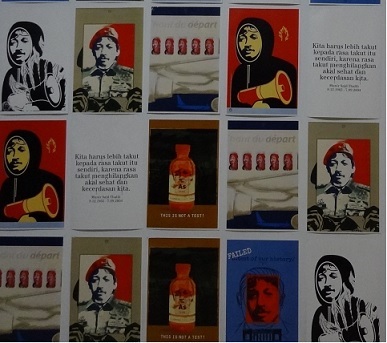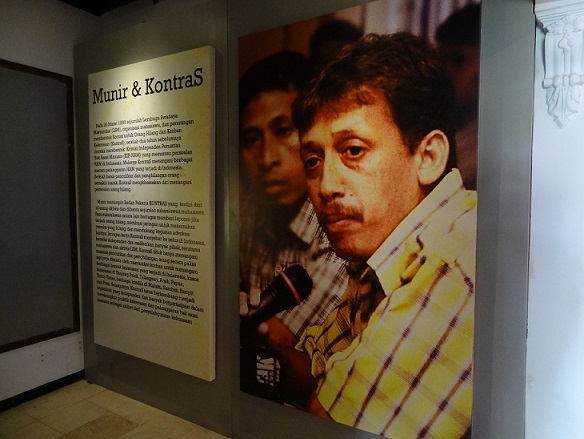A museum dedicated to the memory of the famous activist strives to promote human rights awareness among the younger generation
Vannessa Hearman
Human rights advocate and lawyer Munir Said Thalib was murdered almost ten years ago. He died on board a Garuda plane headed for Amsterdam on 7 September 2004. His last hours on board the flight are charted in detail on the wall of a new museum dedicated to him. The Omah Munir (Munir’s House) is in the hillside town of Batu, 20 kilometres from Malang in East Java. It tells a story where we all know the ending. Yet the blow-by-blow account of his pain and suffering is harrowing to read, especially when one sees, prior to this, an account of Munir’s life and his involvement in key human rights cases in Indonesia in the 1990s and early 2000s. Munir had become a well-known figure in the world at the time of his murder, receiving a number of awards and recognition for his advocacy work.
Batu, dubbed ‘the city of flowers’, is a resort town and a place of fecund beauty with its natural springs, lush mountains and bountiful agricultural produce. Omah Munir is located on the main road to Selecta, a picturesque bathing spot that has long been popular with locals. Batu was Munir’s hometown. After his childhood here Munir became a student activist at Brawijaya University in Malang, before joining the Legal Aid Foundation as a lawyer, where he met Suciwati the woman who later became his wife. The house (later to become the Museum) was, as Suciwati told me, very meaningful to the couple who had purchased it together and had hoped to live many happy years there.
A life well lived
The museum was opened on 8 December 2013, on what would have been Munir’s 48th birthday. Expecting 75 invited guests Ari, a museum staff member, told me they were overwhelmed when 500 people showed up, such was the public interest. A group headed by Andi Achdian and Erwin Kusuma designed and created the museum. Achdian had previously designed the Museum Polri, the Indonesian National Police museum in Jakarta. A history graduate from the University of Indonesia, Achdian’s professional touch is evident in the methods of display and the tone of the museum. The museum weaves Munir’s personal story into the bigger picture journey of human rights campaigning in Indonesia. Human rights campaigning is not easy to popularise in Indonesia today, but Munir’s life elicits much interest, as is often the case with personal stories. His story has become a staple of human rights campaigning worldwide.
One of the wall panels places the beginning of modern human rights campaigning in Indonesia at 1966, the year in which LP-HAM (Institute for the Defence of Human Rights) was founded by Yam Thiam Hien, Poncke Princen and other activists. There is plenty of text in the panel displays, requiring a high level of literacy to take in. The reliance on text is balanced by the photographs and other displays of the museum. Other panels show Munir’s early years, his involvement in labour advocacy, the 1993 murder of unionist Marsinah, the 1993 Nipah land dispute in Madura, and crimes by the Indonesian military and militias in East Timor in 1999 – all cases in which Munir had some role as a lawyer. These information panels are placed alongside signs that exhort visitors to ‘oppose forgetting’ (melawan lupa) and highlight impunity in Indonesia. The museum does not aim to glorify Munir but to place him in the context of the human rights struggles of the 1990s, leading up to Suharto’s ousting in 1998 and his tragically shortened role in human rights campaigns up to 2004.
The museum, according to Suciwati, aims to influence young Indonesians and how they view and value human rights, although visitors are diverse. Suciwati’s goal suggests she sees the formation of rights-respecting citizens as a more important long term goal than simply relying on Indonesia’s legal system to bring Munir’s killers to account. According to Ari, the museum averages about ten visitors a day. Because of its location, during holidays there is plenty of tourist traffic up the Selecta road and the museum gets an influx of visitors as people stop on their way to the resort. Another staff member told me, “People stop because they are curious about the banners outside saying ‘Fighting against forgetting’. They come in and ask what this place is about.” Eliciting enough visitor interest through the banner displays outside is one thing, but the museum places importance on getting its message across to young people, as Suciwati believes that young people often know very little about the campaign to unseat Suharto and that ended his repressive regime in 1998.
The museum uses audiovisual techniques to present simple messages about what constitute human rights. A screen in a small room off the main exhibition space shows simple cartoons about basic rights such as the right to asylum, religious freedom and so on. Another screen has a slideshow of photographs of Munir, while yet another displays a slideshow of relevant newspaper clippings. A wall of pop art showing in various forms the distinctive ‘Munir head’, now a symbol at many a demonstration in Indonesia, is colourful and eye-catching. This features quotes from Munir such as, ‘We must be more afraid of fear itself, because fear erases our rational thinking and intellect.’ A graffiti wall is at the back of the museum for visitors to express their feelings about what they have just seen, in addition to the usual guest book. Life-sized Munir cardboard cutouts add points of interest for young people who like to be photographed next to them.
 The inclusion of Munir’s every-day possession such as his clothing and running shoes is also part of trying to attract the interest of a younger demographic. A simple label explains that he often wore his favourite t-shirt when at home with his family. It is slightly stretched around the collar, obviously much loved, and reads ‘Burma - ASEAN’s Shame’. His worn out motorbike jacket, a bullet proof vest from the time he investigated the 1999 violence in East Timor, his sturdy wooden desk from Surabaya Legal Aid and the awards he received all point to a full and exciting life.
The inclusion of Munir’s every-day possession such as his clothing and running shoes is also part of trying to attract the interest of a younger demographic. A simple label explains that he often wore his favourite t-shirt when at home with his family. It is slightly stretched around the collar, obviously much loved, and reads ‘Burma - ASEAN’s Shame’. His worn out motorbike jacket, a bullet proof vest from the time he investigated the 1999 violence in East Timor, his sturdy wooden desk from Surabaya Legal Aid and the awards he received all point to a full and exciting life.
A murder unpunished
The museum is one way for people who knew and admired Munir to sidestep the recalcitrance they have witnessed in the investigations into his murder. Condemning impunity is such a strong theme of the museum precisely because those who conspired to kill Munir have enjoyed it thus far. In October 2013, Indonesia’s Supreme Court cut the 20-year sentence of the man convicted of murdering Munir, former Garuda pilot Pollycarpus Budihari Priyanto, to 14 years. Human rights campaigners argue that Munir’s murder can be traced to figures within the country’s intelligence community. Muchdi, an official in BIN (the State Intelligence Agency) had been in frequent contact with Pollycarpus in the period surrounding Munir’s death. He was charged with the murder but was acquitted by the South Jakarta District Court in 2008. Suciwati has felt continuously disappointed by the Indonesian justice system. Therefore, she told me the museum shows that it is possible to achieve things on a social level, rather than pinning all hopes on the Indonesian justice system.
Some of the museum staff are activists from the Batu area. They are involved in local community campaigns, such as those promoting protection of water springs threatened by inappropriate development. The museum exists, according to Suciwati, thanks to the support she has received through donations and publicity. She admired the way in which cultural performers have been quick to organise activities to support the museum initiative, and millions of rupiah have been raised through fundraising nights involving Jakarta performers
When I visited, a café and merchandise shop was being constructed next to the exhibition centre. Workshops on human rights will also be held at the museum, and Suciwati speaks of organising a tour of significant human rights sites in Indonesia. She has also ensured that Omah Munir is included in the list of tourist attractions to visit in Batu, hoping to reach new audiences who might not have heard of Munir before.
The opening of Omah Munir may well be the spark Indonesian human rights campaigning needs. At a time of growing nostalgia for Suharto and his era, it is important for Indonesia to be reminded about the origins of its modern human rights movement under the New Order regime. The museum has already reinforced some of the ties that had already been built up within the human rights network. At the museum’s opening, Fajar Merah and Fitri Nganthi Wani, children of poet Widji Thukul, who was disappeared in 1998, performed songs and poems written by their father. Munir had been motivated to set up KONTRAS (Commission for the Disappeared and Victims of Violence) in 1998 as a result of a series of forced disappearances, including that of Widji Thukul.
The museum shows that survivors of state-orchestrated violence can create their own version of history and build something positive out of their suffering, rather than waiting for the state to provide redress. I asked Suciwati how she felt when she saw the museum’s displays finally come together. ‘The rooms have meaning now and while I tried to keep away from being involved in the technical issues of the museum’s content and design, to distance myself from the pain, when I am at the museum it reminds me of the hard work and the love with which it has been put together.’. She added, ‘[To visit this museum] is about taking the inspiration from his life, rather than only the sadness about how it ended.’
Vannessa Hearman (vhearman@gmail.com) is a lecturer in Indonesian Studies at the University of Sydney. An Indonesian translation of this article is published in Loka Majalah.












